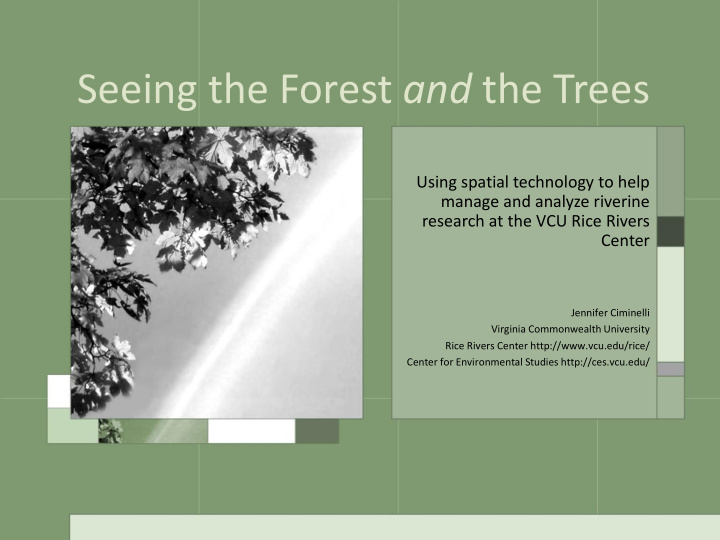



Seeing the Forest and the Trees Using spatial technology to help manage and analyze riverine research at the VCU Rice Rivers Center Jennifer Ciminelli Virginia Commonwealth University Rice Rivers Center http://www.vcu.edu/rice/ Center for Environmental Studies http://ces.vcu.edu/
VCU Rice Rivers Center Part of the Virginia Commonwealth University The VCU Rice Rivers Center is comprised of approximately 500 acres along the James River in Charles City County, Virginia Habitat includes tidal and non-tidal wetlands, upland and bottomland forest, a pine forest, open meadow and vernal pools. Facilities include Education Building, Pier and boat house. Future plans include a lodge and dedicated research building.
VCU Rice Rivers Center Promoting better understanding and knowledge of the environment, the river we live on and the natural resources that nourish life
What We Do The Research Core Team: Science and policy of large Director rivers and their fringing riparian Research Director and wetland landscapes Data and Research Inform public policy Coordinator IT Director Undergraduate and graduate education Director of Wetland Studies Outreach Facility Director / Manager Education and Outreach Onsite facility manager Faculty / Affiliate Faculty Researchers
Driving Mission "...to be internationally recognized for our academic programs focused on scientific research, education and public outreach, and for informing public policy related to river ecosystems, their watersheds and the conservation of species that inhabit those watersheds."
Organize Tools to Help Data Create, Collect Management Rice Rivers and Plan Communicate Center Research, Data and Education Outreach Instrumentation Research / On-Site Resource Protocol Tracking
Instrumentation Active: Mesocosms Seismometer Wi-Fi access points Meteorological tower Water quality instrumentation VEMCO receivers Coming Online: Carbon flux tower Pandora Buoy (connected to the Chesapeake Bay Interpretive Buoy System)
Real Time Data
Research on the Site Focus is riverine research but research includes: Effects of urbanization on the black widow Owl surveys Prothonotary Warbler long term study Baseline assessment of Kimages Creek hydrology and geomorphology Carry-over effects of the larval environment on post metamorphic performance of spotted salamanders Sturgeon restoration project Wetland restoration project Temporal dynamics of nitrite reductase expression Effects of urbanization on parasitism levels of the fall cankerworm Pupal predation of the gypsy moth Effects of tidal forcing on water quality Assessing saltwater disturbance on tidal freshwater wetlands Carbon sequestration and greenhouse gas fluxes of restored and old-growth forested wetlands
Bigger than just a site Rice Rivers research includes research conducted on the site and research funded by Rice Rivers support Includes: Assessment of fishery response to oyster reef restoration and the trophic pathways that link the resource to the reef. Population viability of common snapping turtles in Virginia waterways The Effect of Proximity to a Coal-Fired Power Plant in Central Virginia on Fly Ash and Concentrations of Trace Metals
Apps and Tools to Help Administrators Leverage ArcGIS Online Apps to create interactive, dynamic maps of research and instrumentation Create GIS services of research sites and instrumentation sites Server in house versus leveraging the ArcGIS cloud (credits) Create ArcGIS Online map with sites Edit pop-ups to include links to real time data and researcher specific information Expose map as a web app
Apps and Tools to Help Researchers Trimble GPS ArcGIS Online Collector Drone
Near IR orthomosaic from SenseFly eBee UAS 3cm/pixel
Near IR Point cloud from SenseFly eBee UAS
Nadir View – Rice Rivers center
Application Got the tools…. who and how do we use them?
Tidal Wetland Restoration Project
Restoration of Atlantic sturgeon in Virginia’s coastal rivers The Atlantic sturgeon (Acipenser oxyrhynchus) is the largest and longest-lived aquatic organism in the Atlantic rivers of North America. The Atlantic sturgeon played a critical role in the establishment of the first English settlement as Jamestown’s ‘founding fish’ and was (and remains) culturally significant to Native Americans throughout the region. Following centuries of over-fishing, habitat alteration, and pollution, this migratory species has been extirpated from many Chesapeake Bay tributaries and — in Virginia — persists as a small but viable population only in the James River. As a consequence of the species’ long decline and current rarity, biologists understand very little about sturgeon behavior, movements and reproduction in Virginia waters. This lack of knowledge prevents effective management and restoration of the species in Virginia. In recognition of its imperiled status, the U.S. Fish and Wildlife Service (USFWS) recently proposed the Atlantic sturgeon for listing as a federally threatened species.
VEMCO Fish Receivers
We have the data…. Now let’s help tell a story Identify communication needs
The Use of GIS as a Messaging Tool Administrators happy? Researchers happy? Done! What’s the next step? Bridge the gap from science to public to help inform public policy
Following the Footprints
Next Steps Implement policy Refine and deploy tools in an easily accessible way Expand ArcGIS analytical capacity to help with research (i.e. consulting services) Expand the use of ArcGIS online to help communicate our message
Meteorological tower
Recommend
More recommend